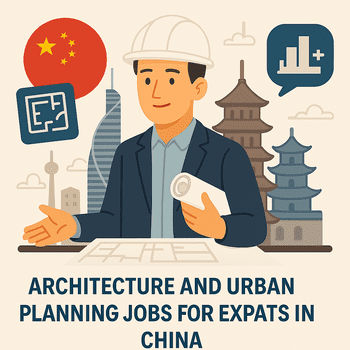
China’s architectural landscape continues to evolve at an unprecedented pace, creating unique opportunities for foreign architects and urban planners.
However, the path to securing meaningful employment in this sector has become increasingly complex.
This guide provides current, practical insights into China’s architecture and urban planning job market for foreign professionals, addressing visa requirements, regional differences, compensation expectations, and effective strategies for navigating this specialized field.
1. Current Visa and Work Permit Framework for Architecture Professionals
Foreign architects and urban planners must navigate China’s tiered work permit system, which evaluates candidates based on education, experience, and specialized skills.
Work Permit Classification for Architecture Professionals (2025)
| Category | Points Required | Typical Qualifications | Annual Quota Status |
|---|---|---|---|
| Class A (High-end talent) | 85+ points | Internationally recognized architects, award winners, senior partners at global firms | No quota limit |
| Class B (Professional talent) | 70-84 points | Licensed architects with 5+ years experience, master’s degree holders | Subject to quota |
| Class C (Entry-level) | Below 70 points | Recent graduates, junior designers | Highly restricted |
Key Documentation Requirements:
- Architecture license/registration from home country
- Portfolio of completed projects
- Proof of education (with Chinese embassy authentication)
- Employment contract with Chinese firm
Sources:
2. Regional Opportunities and Market Differences
Architecture and urban planning needs vary significantly across China’s diverse regions, with distinct project types and hiring practices.
Regional Architecture Market Analysis (2025)
| Region | Project Types | Foreign Hiring Trend | Competitive Advantage |
|---|---|---|---|
| Beijing-Tianjin-Hebei | Government facilities, cultural institutions, urban renewal | Moderate (↔) | Heritage expertise, sustainable design |
| Yangtze River Delta | Commercial complexes, transit-oriented development | Strong (↑) | International design experience, mixed-use expertise |
| Greater Bay Area | Tech campuses, smart city infrastructure | Very Strong (↑) | Innovation in sustainable design, digital integration |
| Chengdu-Chongqing | New urban districts, tourism facilities | Growing (↑) | Experience with rapid urbanization, cultural sensitivity |
| Second-tier cities | Residential complexes, commercial centers | Limited (↓) | Specialized niche expertise only |
Regional Insights:
- Shanghai leads in international firm presence with over 60 foreign architecture offices
- Shenzhen emphasizes technology-integrated architecture and carbon-neutral design
- Beijing focuses on cultural projects and government facilities with stricter approval processes
- Chengdu and Suzhou offer emerging opportunities with less competition
Source: China Construction Industry Report 2025
3. Compensation and Benefits Reality
Salary expectations for foreign architects have evolved significantly, with compensation now more closely aligned to position, experience, and firm type rather than expatriate status alone.
Compensation Ranges by Position and Location (Monthly in CNY)
| Position | Tier 1 Cities | New Tier 1 | Tier 2 Cities | International vs. Local Firm Premium |
|---|---|---|---|---|
| Junior Architect | ¥15,000-25,000 | ¥12,000-18,000 | ¥8,000-15,000 | +20-30% at international firms |
| Mid-level Architect | ¥25,000-40,000 | ¥18,000-30,000 | ¥15,000-25,000 | +15-25% at international firms |
| Senior Architect | ¥40,000-80,000 | ¥30,000-60,000 | ¥25,000-45,000 | +10-20% at international firms |
| Design Director | ¥80,000-150,000+ | ¥60,000-100,000 | ¥45,000-80,000 | Varies significantly by reputation |
Benefits Considerations:
- Housing allowances now typically limited to senior positions (¥8,000-20,000/month)
- International health insurance increasingly replaced by local premium plans
- Annual home leave allowance becoming rare except for partner-level positions
- Project completion bonuses common in larger firms (5-15% of annual salary)
Sources:
4. Credential Recognition and Licensing Requirements
Foreign architects face specific challenges regarding license recognition and practice limitations in China.
Architecture License Recognition Framework
| Country of Origin | Recognition Status | Additional Requirements | Practice Limitations |
|---|---|---|---|
| US, UK, Australia, Canada | Partial recognition | Local examination on Chinese building codes | Cannot sign off on certain government projects |
| EU Countries | Varies by country | Case-by-case evaluation | Limited signature authority |
| Other Countries | Limited recognition | Comprehensive examination | Must work under Chinese licensed architect |
Key Certification Bodies:
- National Council of Architectural Registration Boards
- Architectural Society of China
- China Association of Urban Planning
Licensing Strategy:
- Partner with Chinese-licensed architects for project approvals
- Pursue China Green Building certification for sustainability specialists
- Consider the Foreign Expert Certificate as an alternative pathway
5. Firm Structures and Integration Models
Understanding how foreign architects typically integrate into the Chinese market is essential for job seekers.
Common Employment Models for Foreign Architects
| Model | Description | Prevalence | Best For |
|---|---|---|---|
| International firm China office | Global firms with established China presence | High in tier 1 cities | Mid-career professionals with firm loyalty |
| Design consultant to Chinese firms | Foreign expertise on specific project aspects | Growing trend | Senior specialists with niche expertise |
| Joint venture partnerships | Collaborative firms with Chinese partners | Declining | Entrepreneurs with existing Chinese network |
| Direct employment by Chinese firm | Full integration into local company | Increasing | Those seeking immersive experience |
| Government/academic advisory | Consulting on public projects or teaching | Limited but prestigious | Established professionals with public sector experience |
Notable International Firms with Strong China Presence:
6. Project Types and Foreign Architect Involvement
Foreign architects tend to work on specific project types, with varying levels of creative control and responsibility.
Project Access by Architect Origin
| Project Type | Foreign Architect Access | Typical Role | Notable Examples |
|---|---|---|---|
| Government/civic | Limited, usually concept only | Design consultant | National Grand Theater (Paul Andreu) |
| Commercial/mixed-use | High, especially international brands | Lead designer | Shanghai Tower (Gensler) |
| Cultural institutions | Moderate, often through competitions | Concept architect | West Bund Museum (David Chipperfield) |
| Residential developments | Limited except luxury projects | Design consultant | Linked Hybrid Beijing (Steven Holl) |
| Educational facilities | Moderate, especially international schools | Lead designer | NYU Shanghai (KPF) |
| Sustainable/green projects | High, especially with certification expertise | Sustainability consultant | Shanghai Tower (Gensler) |
Project Approval Process:
- Foreign designs typically require partnership with Local Design Institutes (LDIs)
- Complex multi-stage approval process for large-scale projects
- Increasing emphasis on sustainability metrics in project approvals
7. Cultural Workplace Considerations
Chinese architecture firms operate with distinct hierarchical structures and communication norms that foreign professionals must navigate.
Workplace Culture Comparison
| Aspect | Chinese Firm Norm | Western Firm Norm | Adaptation Strategy |
|---|---|---|---|
| Decision-making | Top-down, centralized | Collaborative, team-based | Respect hierarchy while offering ideas tactfully |
| Working hours | Extended (often 9-9-6) | More regulated | Set boundaries while demonstrating commitment |
| Design feedback | Indirect, relationship-focused | Direct, project-focused | Learn to interpret subtle feedback |
| Client relationships | Highly personal, frequent meetings | More formalized, scheduled | Invest time in relationship building |
| Project timelines | Compressed, rapid execution | Phased, methodical approach | Develop efficient workflows for fast turnarounds |
Cultural Integration Resources:
8. Effective Job Search Strategies
Finding architecture positions requires specialized approaches beyond general job boards.
Architecture-Specific Job Resources
| Resource Type | Platform | Focus | Effectiveness |
|---|---|---|---|
| Industry-specific job boards | Archinect Jobs China | Design positions | High for design roles |
| Architecture recruitment agencies | Architzer Talent | Mid to senior positions | Very effective for experienced architects |
| Professional networks | Architecture China LinkedIn Group | Networking, hidden jobs | Essential for senior positions |
| University alumni networks | CAFA, Tsinghua, Tongji Architecture departments | Academic and practice connections | Excellent for academic positions |
| Architecture competitions | Competitions.archi | Project-based opportunities | Entry point for new firms |
Effective Application Materials:
- Digital portfolio optimized for Chinese platforms (WeChat-friendly format)
- Resume highlighting specific technical skills and software proficiency
- Project sheets demonstrating relevant experience to Chinese market needs
- References from respected industry figures (particularly important in China)
9. Professional Associations and Networking
Industry organizations provide crucial networking opportunities and professional development.
Key Architecture Organizations in China
| Organization | Focus | Membership Value | Events |
|---|---|---|---|
| Architectural Society of China | Professional standards, industry advocacy | High for networking | Annual conference, regional exhibitions |
| China Green Building Council | Sustainable design, certification | Essential for sustainability specialists | Certification workshops, green building tours |
| Foreign Architecture & Design Society – Shanghai | Expat architect community | Excellent for newcomers | Monthly meetups, firm tours |
| Urban Land Institute China | Real estate development, urban planning | High for commercial architects | Quarterly forums, development site visits |
Networking Strategy:
- Attend major events like China International Architectural Decoration & Design Fair
- Join WeChat groups for architecture professionals (typically by invitation)
- Participate in design competitions and public lectures at universities
- Connect with architecture media platforms like Arch Daily China
10. Case Studies: Success Stories
Learning from foreign architects who have successfully established careers in China provides valuable insights.
Notable Foreign Architects in China
| Architect | Background | China Career Path | Key Projects |
|---|---|---|---|
| Ole Scheeren (German) | Partner at OMA | Established Büro Ole Scheeren in Beijing | CCTV Headquarters, Guardian Art Center |
| Lyndon Neri & Rossana Hu (Chinese-American) | Started in US firms | Founded Neri&Hu in Shanghai | The Waterhouse, Suzhou Chapel |
| Benjamin Wood (American) | SOM background | Founded Studio Shanghai | Xintiandi, Tiandi Promenade |
| Zhu Pei (Chinese-American) | Studied at UC Berkeley | Returned to establish Studio Zhu-Pei | Minsheng Museum, Jingdezhen Imperial Kiln Museum |
Career Progression Insights:
- Most successful foreign architects either:
- Transfer within international firms to China offices
- Build reputation abroad before establishing presence in China
- Partner with established Chinese architects or developers
- Teaching positions at prestigious universities often complement practice
Conclusion
China’s architecture and urban planning sector offers significant opportunities for foreign professionals, but success requires strategic preparation, cultural adaptability, and specialized expertise.
The most successful foreign architects in China combine technical excellence with cross-cultural fluency and patience in navigating complex regulatory systems.
While challenges exist, those who invest in understanding China’s unique architectural context can contribute meaningfully to its evolving built environment.
Additional Resources:


